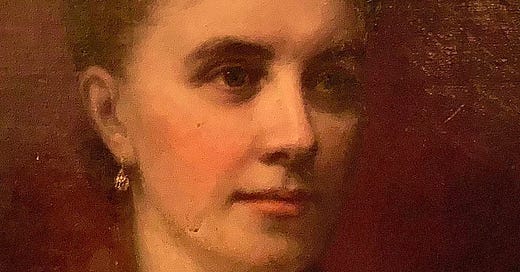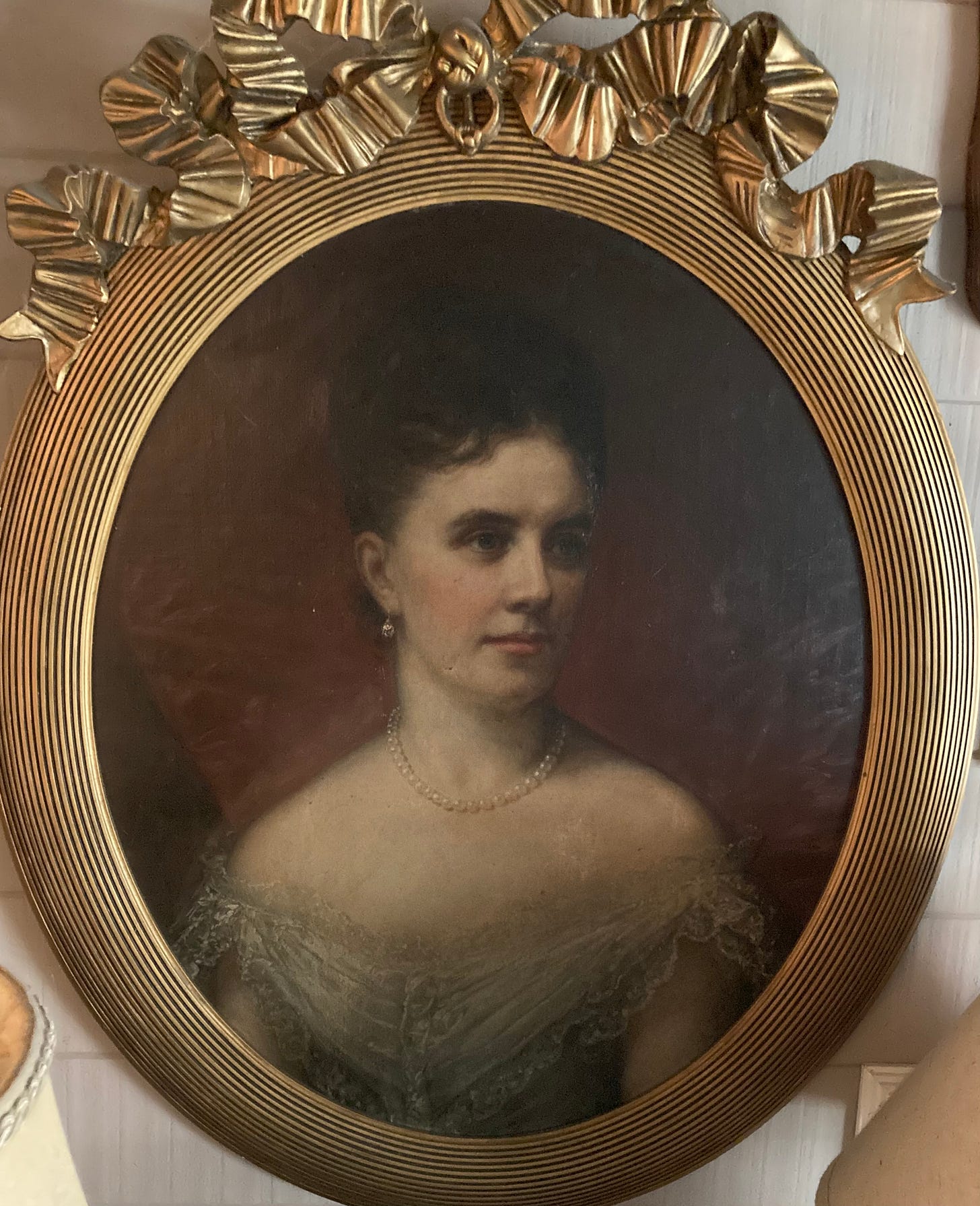The large oil painting hanging on my office wall reminds me virtually every day of a strange and embarrassing connection my family has to the failed impeachment of former President Donald Trump.
The portrait is of the extravagant 19th century socialite Amanda Tomlinson Bower Belknap, a Kentucky belle whose radiance, it was said, was rivaled only by her rapaciousness. It is a nice painting, surely, but her presence on my wall can be attributed to the slightly awkward reality that Amanda Belknap is my great great grandmother
.
The notorious beauty died more than a century ago and is now a forgotten figure in history, but anyone who watched the second impeachment trial of Donald Trump probably heard about her husband, William Worth Belknap, my great great grandfather.
Belknap, the secretary of war under President Ulysses Grant, was impeached in 1876 for taking illegal kickbacks from an Army trading post. The Belknap trial, held after he resigned, was used as a precedent for Trump's impeachment, which, had it been successful, would have prevented his second run for president and, possibly, some of the fraught criminal proceedings we are now witnessing.
Trump was acquitted on the same technicality that was used as an excuse to clear Belknap — that he could not be kicked out of an office he no longer held.
Belknap's name was bandied about on television and in print during Trump's impeachment trial, but the real story -- the one that features my female ancestor -- was never told.
The Belknap case is, in fact, a remarkable tale of intrigue during a turbulent crossroad after the Civil War when America was focusing its attention on the western frontier. It involves a secret scheme that harmed both cavalry soldiers and plains Indians, hurt the frontier peace process and may have played a part in one of the most notorious massacres in American history. It was a caper that Amanda Belknap knew all about.
The revelations of dirty dealing shocked the nation at the time because Secretary Belknap was well liked in the Grant Administration and famous for his heroics in the Civil War.
A former state legislator from Keokuk, Iowa, he was a big, gregarious man with a red beard and booming voice. During the Civil War he led the Fifteenth Iowa regiment in a charge at Shiloh where he was wounded and had his horse shot out from under him.
“Major Belknap, though severely wounded, was equal to the demands of this supreme moment of peril,” recalled the surgeon, Dr. William Gibbon, who was with the Fifteenth during the battle. “He rallied the regiment with great ability.”
His legend for gallantry was sealed during the bloody Battle of Atlanta on July 22, 1864 when he dragged a Confederate colonel by the coat collar across the battlefield during hand-to-hand combat and personally placed him in custody. By the end of the war, Belknap had been promoted to brigadier general.
President Grant, impressed by Belknap's war record, hired him in 1869 after Secretary of War John Rawlins died. The job put him in charge of Army trading posts on the frontier, where deadly tensions between white settlers and Native Americans were rising.
Belknap's wife, Carrie, wasted no time taking advantage of her husband's newfound clout, arranging for one of her friends to be appointed to the post tradership at Fort Sill, Oklahoma Territory. Corruption at Army trading posts, where reservation Indians and soldiers got many of their supplies, was already a problem, but the post at Fort Sill was particularly tempting because it was so lucrative.
The problem for Carrie and her friend was that another man already held the position. The solution they came up with was to allow the man to stay in his post as long as he paid kickbacks. The illicit deal paid Carrie $6,000 a year.
Carrie Belknap died of tuberculosis in 1870 after only one payment, but not before she had arranged for her sister, Amanda, to continue receiving the money.
Amanda, known affectionately among the beau monde as "Puss," had grown close to Secretary Belknap while taking care of Carrie. Newspapers had long been commenting about her sensational good looks and "queenly grace.” When she married her sister's widower three years later, she became the talk of the town, reigning like a queen over the ladies of the cabinet. She held lavish dinner parties replete with silver cutlery monogrammed with the word “Puss” and sashayed about town wearing emeralds and carrying coral-headed parasols.
“Mrs Belknap was gorgeous,” wrote William McFeeley in Grant, A Biography, published in 1982. “Her marvelous figure was set off by good dresses from Worth and splendid diamonds and pearls.”
William Belknap was not a millionaire — he made $8,000 a year — so his wife’s lavish spending raised eyebrows. Meanwhile, the high prices charged by post traders — presumably to make up for the artificially high cost of doing business — garnered suspicions. In 1876, none other than George Armstrong Custer complained about the unfair prices his cavalrymen were paying at Fort Sill. The complaint by the dashing civil war veteran with long blond hair and a penchant for wearing skins led to an investigation that soon uncovered the illicit payments.
A weeping Belknap pleaded with President Grant to accept his resignation as news of the scandal spread and talk of impeachment circulated through Washington. Belknap hoped to prevent legal proceedings that, he told the president, would tarnish his wife's reputation. The House impeached Belknap anyway and the Senate brought him to trial in the summer of 1876.
Custer was persona non grata after his testimony implicated Grant’s brother Orvil in schemes at other trading posts to, among other things, resell food meant for Indians. Custer's job was apparently on the line when, desperate to impress with a heroic victory, he attacked Lakota Sioux and Cheyenne encampments on June 25, 1876. The impeachment trial was under way when news came out that Custer and five companies of his cavalry were wiped out during the Battle of Little Bighorn, in South Dakota. Some of the Indian warriors allegedly used repeating rifles sold to them at Fort Sill.
Belknap and his defenders claimed that his two wives orchestrated and carried out the scheme and that he was unaware of the kickback deal, which netted a little more than $20,000. It is possible, if unlikely, that he thought Amanda's shopping sprees were financed by inheritance given that she and her sister had their own money. The kittenish Puss Belknap had, after all, made him sign a prenuptial agreement.
Regardless of what he knew, there is no doubt who benefited most from the illicit deal. Although William Belknap’s name is in the history books, Amanda was always the focus of the tale, the center of attention, the star of the show.
The portrait in my office depicts a strikingly attractive woman wearing a pearl necklace, silver earrings and a white, lacy, shoulder-less evening gown that exposes her alabaster skin. Her bright blue eyes and slightly blushed cheeks exude a seductive confidence. It was painted in 1876 by George Healy, who also painted Abraham Lincoln, and it was passed down to me from my grandmother, who displayed it in her Los Angeles and, later, San Francisco homes.
Amanda, who lived separately from her husband for long periods after the scandal, remained a controversial figure and the subject of much gossip throughout her life. She caused a stir in 1889 when she was spotted on Coney Island wearing a risqué red-and-white bathing suit that revealed more of her shapely arms and legs than was thought respectable. Disapproving murmurs were recorded in the society pages when she didn’t make it to the bedside of her gravely ill husband, who died in 1890.
Mrs. Belknap lived for awhile in Paris with her daughter, Alice, who later moved to Los Angeles with her own daughter, also named Alice. The scandal was such that Alice, my grandmother, was allowed to meet her only once, when the infamous Puss was very old. She recalled being shocked by what was thought of at that time as a particularly immodest display of cleavage.
Amanda was visiting her daughter in Los Angeles in 1916 when she suffered a stroke and died.
Historians rarely mention how the belle of the ball helped bring down her powerful husband, but that lady still lives with me in the brush strokes of a Victorian era portrait, her blue-green eyes staring blissfully and ignominiously over my shoulder.






Well, Puss seems to have had a flair for the dramatic. We are judging her by what we know now. That particular characteristic in our DNA seems to thankfully have been recessive. So her daughter was our grandmother, Alice Henry's mother. I heard that she too had some interesting characteristics. Wasn't she some kind of spy or something? How about a story about that?
Love this. Who got her pearls?